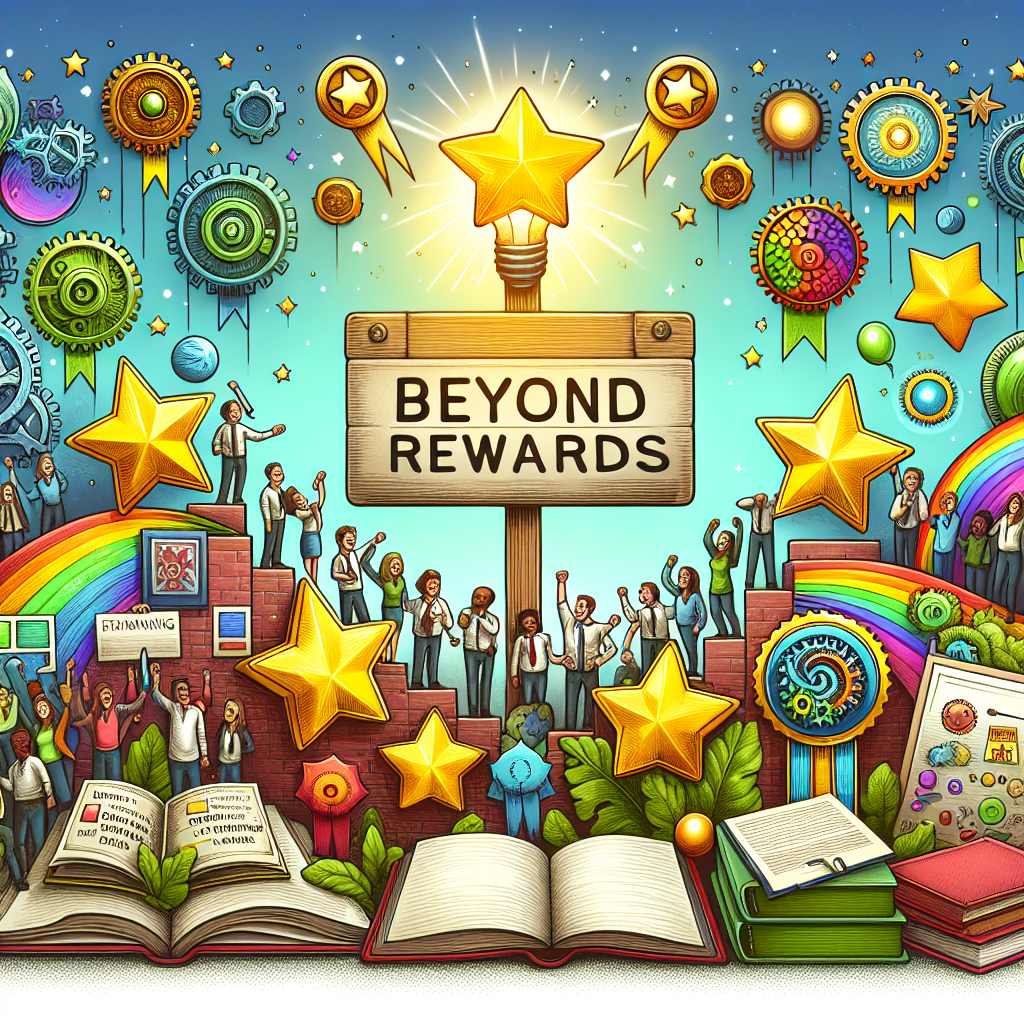
Introduction
In a world where competition is fierce and attention spans are dwindling, the quest for effective motivation and engagement strategies has never been more critical. Traditional reward systems, while useful in certain circumstances, often fail to tap into the intrinsic motivations that drive us forward. Enter the realm of Beyond Rewards: Innovative Approaches to Positive Reinforcement—a transformative perspective that innovatively reshapes how we motivate, inspire, and uplift individuals in various settings, from workplaces to classrooms.
Positive reinforcement is not merely about offering a reward for good behavior; it encompasses a broader, more thoughtful approach to acknowledging accomplishments, fostering growth, and promoting a thriving environment. In this article, we will delve into innovative practices that elevate positive reinforcement beyond the conventional, and explore real-world applications that drive engagement, satisfaction, and performance.
The Evolution of Positive Reinforcement
Traditional vs. Innovative Approaches
Historically, positive reinforcement was synonymous with tangible rewards: bonuses, trophies, or other forms of compensation that often led to short-term motivation. However, researchers and practitioners have recognized that these rewards can sometimes decrease intrinsic motivation, resulting in what’s known as the "overjustification effect."
Innovative approaches now emphasize the importance of intrinsic motivators such as autonomy, mastery, and purpose. Beyond rewards—these methods focus on amplifying engagement through human connection and the cultivation of a supportive environment.
Case Study: Google’s Project Aristotle
Google’s Project Aristotle is a groundbreaking study analyzing what makes teams successful. Surprisingly, the findings revealed that the most important factor is not the individual talent or resources but rather the psychological safety within teams. Employees who felt safe to express their thoughts without fear of negative consequences exhibited higher levels of creativity. This case illustrates that positive reinforcement is more about fostering an environment than merely providing rewards.
| Key Findings | Insights |
|---|---|
| Psychological Safety | Crucial for team success, even more than individual talent |
| Dependability | Teams responsible for their commitments perform better |
| Structure and Clarity | Importance of clear goals for team performance |
Benefits of Going Beyond Traditional Rewards
Fostering Intrinsic Motivation
Incorporating principles of self-determination theory, it becomes clear that autonomy, competence, and relatedness drive individuals to engage wholeheartedly. By recognizing achievements, facilitating growth, and encouraging collaboration, organizations can foster intrinsic motivation.
Enhanced Corporate Culture
Adopting innovative positive reinforcement methods contributes to a healthier corporate culture. Employees feel valued when their contributions are genuinely acknowledged, leading to improved morale, reduced turnover, and heightened productivity.
Increased Creativity and Innovation
When individuals are empowered rather than merely rewarded, creativity flourishes. By creating an environment of trust and collaboration, organizations can derive unique solutions to challenges.
Case Study: IDEO’s Design Thinking Approach
At IDEO, a global design and consulting firm, the principle of innovative problem-solving includes team brainstorming sessions where individuals are encouraged to share wild ideas without immediate judgment. This method nurtures creativity, leading to revolutionary products. Here, positive reinforcement shifts from rewarding results to valuing the process of collaboration and ideation.
Innovative Techniques in Positive Reinforcement
1. Recognition Programs Beyond Monetary Rewards
Recognition programs that celebrate achievements through peer acknowledgments, shout-outs, or personalized notes can significantly impact morale. For instance, a simple ‘thank you’ from a colleague can be more meaningful than a monetary bonus.
2. Purpose-Driven Engagement
Aligning individual roles with organizational goals and fostering a sense of purpose makes work meaningful. When employees understand how their work contributes to larger objectives, their engagement levels soar.
3. Collaborative Learning Environments
Creating spaces where knowledge sharing and skill development occur can foster a positive reinforcement cycle. Organizations can implement mentoring programs, informal lunch-and-learns, or collaborative workshops, enhancing skill sets while reinforcing positive behavior through community support.
4. Personal Growth Opportunities
Offering professional development opportunities, such as training workshops, can empower employees. Rather than focusing solely on performance-weighted rewards, emphasizing personal growth nurtures long-term loyalty and engagement.
Case Study: Salesforce’s Ohana Culture
Salesforce’s Ohana Culture emphasizes family, respect, and inclusion. Employees are encouraged to engage in community service, promoting a sense of purpose beyond profit. This initiative not only strengthens team dynamics but fosters a sense of belonging, highlighting premium innovative reinforcement strategies.
Measuring the Impact of Positive Reinforcement Innovation
Metrics to Consider
Organizations looking to understand the effectiveness of their positive reinforcement strategies should consider various metrics, including:
- Employee Satisfaction Surveys: Regular feedback can help gauge feelings of recognition and job satisfaction.
- Turnover Rates: A declining turnover rate can serve as an indicator of effective motivation strategies.
- Performance Metrics: Tracking results before and after the implementation of innovative reinforcement techniques can offer insights into effectiveness.
| Metric | Pre-Intervention | Post-Intervention |
|---|---|---|
| Employee Satisfaction Score | 65% | 85% |
| Turnover Rate | 15% | 8% |
| Annual Performance Rating | 3.2 | 4.5 |
Conclusion
As we navigate the complexities of human motivation, it becomes clear that Beyond Rewards: Innovative Approaches to Positive Reinforcement are essential for fostering engagement and satisfaction in today’s organizations. By emphasizing intrinsic motivation, cultivating a supportive environment, and creatively recognizing achievements, we can inspire individuals to reach their full potential and drive organizational success.
Inspiring Actionable Insights
To navigate this evolving landscape:
- Focus on creating a culture that prioritizes recognition and connection.
- Incorporate innovative techniques as an integral part of your motivational strategy.
- Continuously evaluate and adjust methods to ensure they resonate with employees’ intrinsic motivations.
FAQs
1. What is the difference between traditional rewards and innovative positive reinforcement?
Traditional rewards often involve tangible incentives, while innovative positive reinforcement focuses on nurturing intrinsic motivations through recognition, purpose, and connection.
2. How can I implement innovative positive reinforcement in my organization?
Consider introducing peer recognition programs, collaborative learning opportunities, and purpose-driven engagement strategies to foster a supportive culture.
3. Are monetary rewards still effective in motivating employees?
Monetary rewards can be effective in the short term but may undermine intrinsic motivation in the long run. Balancing monetary rewards with intrinsic motivators is crucial.
4. Can positive reinforcement techniques be applied in educational settings?
Absolutely! Strategies like encouraging student collaboration, recognizing individual growth, and providing constructive feedback foster student engagement and motivation.
5. How do I measure the effectiveness of positive reinforcement methods?
Consider using employee satisfaction surveys, turnover rates, and performance metrics to assess the impact of your chosen positive reinforcement strategies.
By embracing these innovative approaches to positive reinforcement, we can transform the way we motivate and inspire those around us. The goal is not just to reward good behavior but to cultivate an environment where individuals feel valued, fostering profound engagement and a thriving community.















